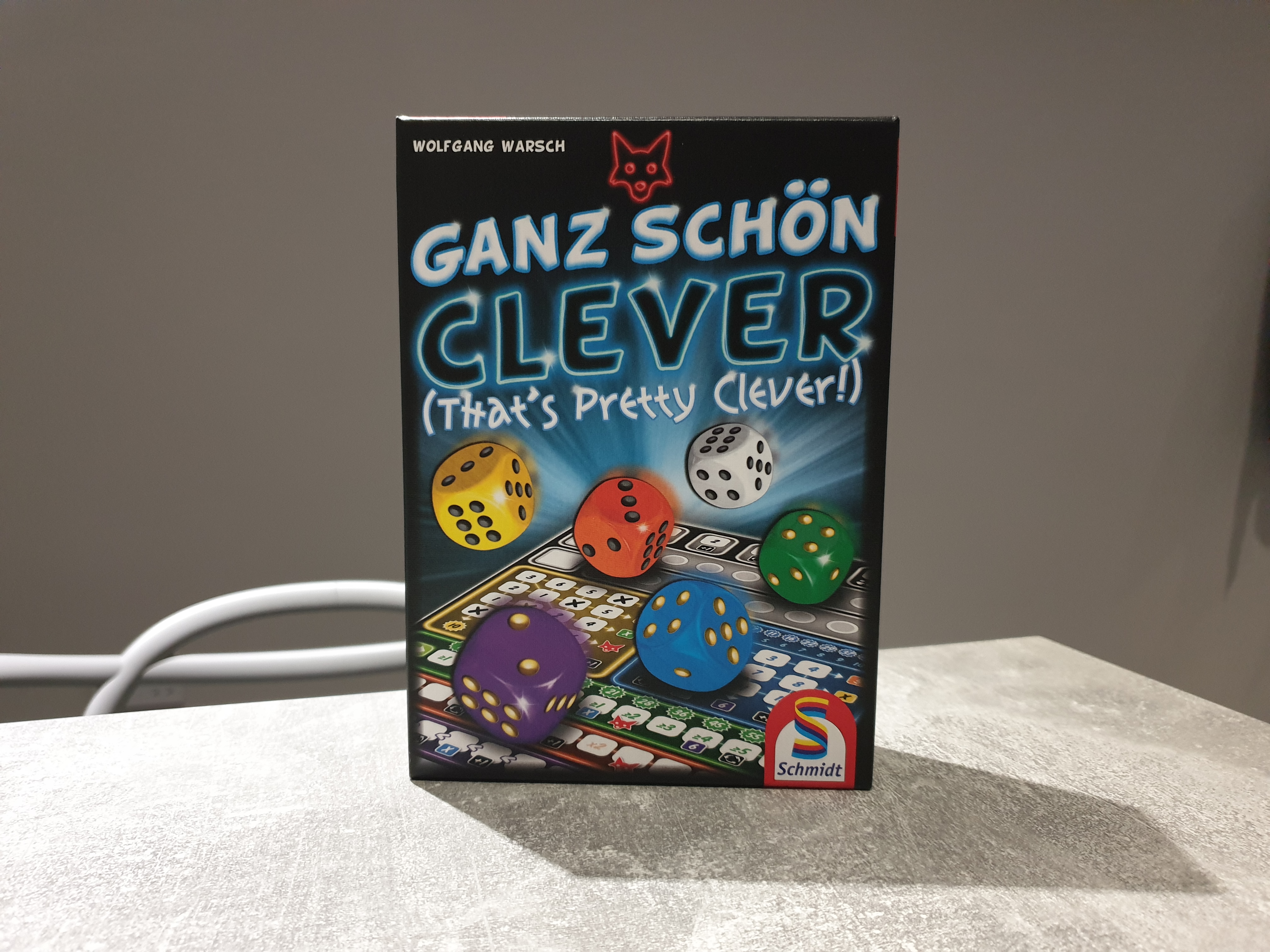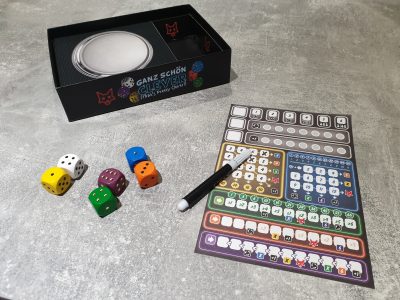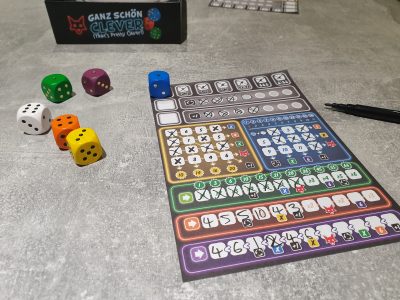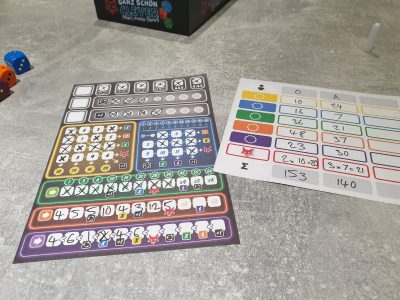Ganz Schön Clever, or as subtitled in English That’s Pretty Clever, is a roll and write board game, which was released in 2018. Designed by Wolfgang Warsch, published by Schmidt Spiele and Stronghold Games, the game is playable either solo or with up to 4 players. Taking around 10 minutes to play, the six coloured dice will be rolls many times, with players aiming to use the dice for big scores. However, with a plethora of other roll and write games released recently, does Ganz Schön Clever do enough to stand out from the crowd? Let’s find out!
Setup is almost just tipping the components out of the box, but with the additional effort of passing everyone a scoresheet and pen. Gamers don’t even need to put the box to one side as the inner of the box is used, showing a silver platter that will be used to discard dice onto. Depending on the player count 4 – 6 rounds will be played, with 6 played with 1 – 2 players, 5 with 3 players and 4 played with 4. Each round every player will get a go at being the active player, being passive players for the rest of the round.
As the active player, players start their go by rolling the 6 different coloured dice. They will choose one of the dice to activate, placing it on their scoresheet and placing dice of lower values onto the silver platter. They then roll the remaining dice, again choosing one to keep and discarding lower valued dice ot the silver platter. This is finally done a third time so that the player has selected three dice. Note, it is possible to not be able to roll/choose any dice – at which point the turn is over.
At this point the passive players can choose any dice on the silver platter to activate for their own scoresheet. If there are multiple passive players they can choose the same die or different silver platter dice. Selecting the dice isn’t just a choice because lower valued dice are removed the different colours score differently on the scoresheet.
Yellow has a grid of numbers, with players able to cross off the number rolled on the yellow dice. Complete columns of yellow score points, while rows of the grid give bonuses. Blue is similar to yellow, but the value crossed off equals the value of the blue die plus the value of the white die. Completing rows and columns offer bonuses, with points earnt equal to the number of values crossed off. Green has requirements of a minimum green die value to cross of a space, unlike yellow and blue being a single long line rather than being a grid. Points are earnt via how far up the line players get, with a couple of bonuses along the way.
Orange is the first colour type to score the value on the dice, with a few opportunities to double the value chosen. Purple is the second colour to do this but the dice values must always increase, with 6 resetting the value to beat along the line. Whilst this is harder than orange to fill in it comes with a lot of bonuses. The final dice colour is white, however it doesn’t have a scoring zone. As well as adding to the blue die for the blue zone it is treated as wild. This means it can be used as any colour for a zone on the scoresheet.
Bonuses come in a lot of forms, including: gaining special foxes, putting a cross in any space in a specific zone, putting a 6 in the purple line, giving the ability for a future reroll to the player and even the ability to select an additional dice at any point – either as the active player or when choosing as a passive player. The latter two of these examples are also awards to players as the rounds progress, giving everyone identical little perks along the way.
At the end of the final round players add up the points they have earnt. Flipping back and forth between the top and bottom of a player’s scoresheet it is possible to score each colour section individually. This makes the scoring an easier task, rather than having to sum all the points up at once – though being on the back of the normal score sheets is a little awkward. At this point the foxes come into play, scoring bonus points based upon the section the player scored lowest on multiplied by the number of fox faces earnt. This is a potentially powerful combination, that takes a few games to work out how to best exploit.
Summing up the totals players can reveal who won but there is also a table/guide in the manual to let players know how well they did. Ranging from “Try Harder!” for below 140 points up to “You’re so clever!” for (somehow) managing to get over 280 points. This table is obviously much more important when playing solo, unless you are just attempting to beat a previous score. The only real difference for a solo game is that as the passive player you roll the 6 dice, moving the lowest three dice to the silver platter before choosing. With this coming with an amazing tiebreaker of which dice is closest to the silver platter.
Unlike a few of the recent roll and write titles Ganz Schön Clever has active and passive players, so the downtime can be longer – especially with more than 2 players. Whilst players do get a single dice choice as a passive player it is only at the end of the active players turn which means you can effectively turn off until the player is finished. This makes the experience a little disjointed, which leads me to suggest playing with either 1 or 2 players.
Ganz Schön Clever takes a game to get into, thankfully they don’t last long! By the end of the first game, players will be able to start to see how things trigger each other, the best times to take dice of specific colours and what values are truly worth taking. From scoring the first game, players will see how they can instantly improve and will almost every time want to jump back in and start rolling for round one of the next game. This isn’t enough of a problem to put people off the game but more of players’ eyes opening to the possibilities of the puzzle in front of them.
The pad included is certainly thick, so will last a long time. This being said, the pad triggers a personal pet peeve that eventually gamers will have burnt through it and be unable to continue playing. Laminating 4 sheets gets around the issue for the long term, with only dry wipe pens needed. This logic though only makes me question why the game doesn’t just come with 4 score sheets on wipeable boards? A lot of roll and write titles unfortunately come with a pad. Yet, after Railroad Ink showed how well a game of the genre could be made with these wipeable boards, others should look to follow.
Ganz Schön Clever as a physical game has an unusual competitor, in terms of itself in digital form. The app works for solo play incredibly well, with some surely getting better value from the digital version. Being able to roll the dice and cross of things on the scoresheet feels nice though, and playing with others helps to stop the game feel a bit samey as their choices directly impact your choices.
I unashamedly like a good amount of numbers, so the look of Ganz Schön Clever’s scorepad doesn’t daunt me. However, many people – especially non-regular gamers – are not quite so accepting. Looking a decent deal more complicated than the likes of Yahtzee, the game does nothing to evoke passion past being a great puzzle. It is a phenomenal puzzle though, so credit must be given. Whether to go for the digital version or the physical version is a personal decision, but the feel of actually rolling dice in a dice based game just seems right – which is why Ganz Schön Clever is staying on my shelf!
[Editor’s Note: Ganz Schön Clever was provided to us by Coiledspring Games for the review. The game is priced at £12.99 on the official product page.]




